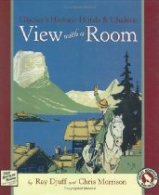| Backcountry Chalets in Glacier National Park |
One of the fairly unique aspects of Glacier National Park are the two backcountry chalets that offer hikers the opportunity to trek to an overnight destination without having to be bogged down with a bunch of camping gear.
Of the two, the Sperry Chalet near Lake McDonald offers a few more amenities and creature comforts than the Granite Park Chalet near Swiftcurrent Pass.
Sperry Chalet
At an elevation of more than 6500 feet, Sperry Chalet sits high on a rock ledge and offers visitors commanding views of majestic mountain peaks, waterfalls, and Lake McDonald in the valley far below.
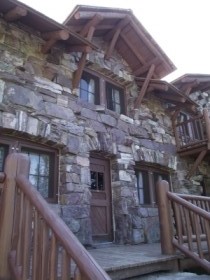 The two main buildings at Sperry consist of a two story hotel and a kitchen/dining room. There’s also a modern composting restroom facility located between the two buildings.
The two main buildings at Sperry consist of a two story hotel and a kitchen/dining room. There’s also a modern composting restroom facility located between the two buildings.
An overnight stay at Sperry includes a sit-down dinner, breakfast, and a packed lunch for your hike back down the mountain the next day. Although there's no electricity on the premises, the cozy dining room does have a wood stove and propane lights. Also, the private guest rooms are without lights, heat or water, and guests must use flashlights at night as no candles or fueled lights are permitted.
For those wishing to visit Sperry on a day hike, you may want to note that the dining room is open to the public from 11:30 to 5:00 every day. They offer a lunch menu that includes soups, sandwiches, pies and snacks. For dinner or breakfast, reservations are required for non-overnight guests, and can be made by calling the reservation office at 1-888-345-2649.
For those who wish to camp in the area, the Sperry backcountry campsite is nearby as well.
There are two trails that lead to the chalet: the Sperry Trail from Lake McDonald, and the Gunsight Pass Trail starting from the Jackson Glacier Overlook on the east side of the park.
Once at Sperry, visitors have several options for additional hiking in the area. One of the favorite destinations is the trek up to Sperry Glacier. This 3.5-mile hike to the headwall at Comeau Pass (elev. 7970 feet), up the stone stairway, and then over to the glacier is considered to be one of the most memorable and magnificent trips in Glacier.
Other side trips include the one-mile scramble up Lincoln Peak (elev. 7440) with its panoramic views, a three-mile walk along the Gunsight Pass Trail to Lake Ellen Wilson (elev. 5929), or all the way up to Gunsight Pass (elev. 6946), at 4.5 miles.
Now listed as an Historic Landmark, the Sperry Chalet was built in 1913 by the Great Northern Railway, and was opened to the public the following year. The dining chalet was built in 1915. Built out of native rock, the rustic buildings have survived their rugged environment relatively unchanged.
The chalet and glacier are named after Dr. Lyman B. Sperry of Oberlin College who scouted for "scenic attractions" on behalf of the Great Northern Railway. Sperry was the leader of the first party to reach the glacier in 1896. He also oversaw the construction of the trail that provided access to the glacier from the Lake McDonald Lodge. The Sperry Trail, constructed in 1902 and 1903 by college boys from Minnesota, was likely the first organized trail-building effort in the park.
In 1992 the Chalet was forced to close due to safety and environmental concerns. Fortunately it was restored and reopened again in 1999.
For more information and to make a reservation, please click here.
Compared to its sister to the south, the Granite Park Chalet is much more basic, and is essentially a simple hiker's hostel with virtually no amenities. It has 12 guest rooms, each with 2 to 6 bunks. There’s no electricity, but the common-area kitchen has a propane stove. But don't let this deter you, the views here are simply spectacular! Perched on the edge of an alpine meadow, the chalet overlooks the McDonald Valley, and has a birds-eye view of Heavens Peak.
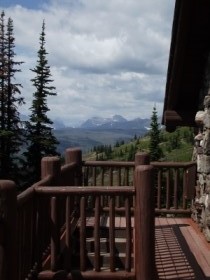 Since there's no restaurant at Granite Park, overnight guests are encouraged to bring their own food. The chalet, however, does sell packaged foods, beverages, snacks, and bottled water, and provides overnight guests with the option of pre-ordering from a menu of freeze dried foods to have when they arrive.
Since there's no restaurant at Granite Park, overnight guests are encouraged to bring their own food. The chalet, however, does sell packaged foods, beverages, snacks, and bottled water, and provides overnight guests with the option of pre-ordering from a menu of freeze dried foods to have when they arrive.
If not interested in buying water, there's a stream about 0.25 miles away along a rocky and rugged trail. Be advised, however, that any water fetched from this source needs to be treated.
There are four trails that lead to the Granite Park Chalet. The Highline Trail, at 7.6 miles, is by far the most popular. The Granite Park Trail from "The Loop", at 4.2 miles, is the shortest, but climbs 2300 feet. The Swiftcurrent Pass Trail out of Many Glacier is 7.6 miles in length and climbs 2400 feet. The fourth option is a very long trek from Goat Haunt near the Canadian border.
From the chalet hikers have a couple of opportunities for short hikes to additional sights such as the Swiftcurrent Lookout Tower or the Grinnell Glacier Overlook.
The Granite Park Chalet was built in 1914 and 1915 by the Great Northern Railway to provide comfortable backcountry accommodations inside Glacier National Park. The rustic lodge was the last of the chalets built by the railroad, and today is listed as a National Historic Landmark. As a result of the difficulty in maintaining the chalet, the Great Northern Railway sold the chalet to the National Park Service in 1954 for the princely sum of just $1.00.
As with Sperry, the Granite Park Chalet was forced to close as a result of safety and environmental concerns, but was reopened in 1996.
For more information and to make a reservation, please click here.
Did you know that there were a total of nine backcountry chalets in Glacier National Park at one point? So what happened to the other seven?
In the early 1900s some Americans were becoming alarmed over the increased spending of American dollars on European travel. While discussing Glacier one day, Senator "Pitchfork Ben" Tillman of South Carolina stated: "It is very ridiculous to me to see the amount of money spent by Americans to see the scenery of Europe without having first seen what we have at home." This concern provided one of the motivations for the creation of a national park at Glacier. Having an "American Alps," or a "Switzerland of the United States," such as Glacier, allowed America to compete against Canadian and European resorts and tourist attractions.
The Great Northern Railway played an extremely important role in the establishment of a national park during this time period as well. The Great Northern had a rail line running along the southern edge of Glacier, and saw the establishment of a national park as a way of increasing passengers on their trains, while also increasing their revenues.
So it was against this backdrop that the president of the Great Northern Railway, Louis W. Hill, began building a number of hotels and chalets throughout the park in the 1910s as a way of promoting tourism. These buildings were modeled on Swiss architecture - as part of Hill's plan to portray Glacier as the "American Alps" or "America's Switzerland". Included in this project was a network of 9 European-style chalet complexes. Thus, leaving from one of Hill's luxury lodges, guests could hike or ride to one the rustic chalets in less than a day.
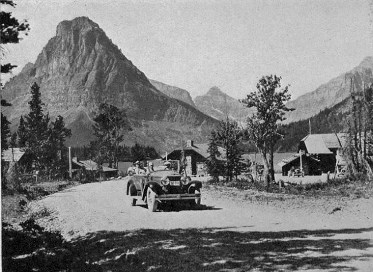
The chalets, built between 1910 and 1915, included Sperry, Granite Park, Cut Bank, Goat Haunt, Going-to-the-Sun (also known as Sun Point), Many Glacier, Gunsight Lake, one of the Two-Medicine Chalets (photo above - the other was converted into a store, which is still in use today) and St. Mary (photo below). In their prime, several of the chalets would host 100 to 150 guests a night. (both photos via the National Park Lodge Architecture Society)
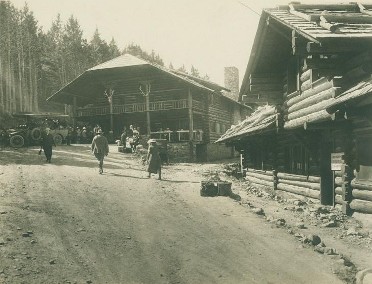
Today, only Sperry and Granite Park remain. Both owe their survival to the use of native stone as their primary construction material. The masonry of these chalets made it possible to withstand Montana's brutal winters. In contrast, the wooden structures of the other chalets deteriorated so badly that many had to be razed during the late 1940s.
The first chalet to meet its demise was Gunsight Lake when it was destroyed by an avalanche in 1916. The Many Glacier Chalets were burned down during the massive Heavens Peak forest fire of 1936. During WWII the remainder of the chalets were closed. The lack of use during the war years forced a reassessment of the facilities, and by 1944, park officials agreed that the St. Mary Chalet was no longer necessary and was subsequently destroyed. Similarly, the chalets at Cut Bank and Sun Point were regarded as "beyond repair" and an "eyesore" and were destroyed by 1949. Finally, the structure used for lodging at Two-Medicine was razed and burned in 1956.
It's a shame that America had to lose all those historic structures. Too bad the Great Northern Railway didn’t have the foresight to build more of the chalets out of native stone. Modern day hikers would've had even more overnight destinations from which to consider - without having to rough it! For a far more in-depth history of Glacier's backcountry chalet system, I highly recommend View with a Room.

